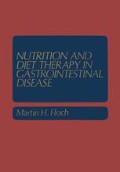Abstract
Weight loss occurs because of inadequate caloric intake. [Optimal body weights are described in Chapter 2 (Table 2-6).] Weight loss is a state of malnutrition. However, malnutrition also includes obesity and disorders that result in overnutrition as well as undernutrition. Furthermore, malnutrition includes selective deficiencies in proteins, vitamins, and minerals such as described in Chapters 2 and 3. A simple lack of food supply remains the greatest cause of decreased caloric intake in the world. Consequently, starvation, kwashiorkor, and marasmus are the most common diseases resulting from inadequate food supply and are seen frequently in underdeveloped societies. Obviously, these are due to economic and sociologic factors rather than body disorders or digestive diseases.
Access this chapter
Tax calculation will be finalised at checkout
Purchases are for personal use only
Preview
Unable to display preview. Download preview PDF.
References
Hall RJD: Progress Report—Normal and abnormal food intake. Gut 16: 744, 1975.
Bollet JB, Owens S: Evaluation of nutrition status in selected hospitalized patients. Am J Clin Nutr 26: 931, 1973.
Butterworth CE: The skeleton in the hospital closet. Nutr Today 9: 4, 1974.
Bistrian BR, Blackburn GL, Vitale J, et al: Prevalence of malnutrition in general medical patients. JAMA 235: 1567, 1976.
Hill GL, Pickford I, Young GA, et al: Malnutrition in surgical patients. An unrecognized problem. Lancet 1: 689, 1977.
Weinsier RL, Hunker EM, Krumdieck CL, et al: Hospital malnutrition. A prospective evaluation of general medical patients during the course of hospitalization. Am J Clin Nutr 32: 418, 1979.
Theologlides A: Anorexia-producing intermediary metabolites. Am J Clin Nutr 29: 552, 1976.
Swanson DW, Swenson WM, Huizenga KA, et al: Persistent nausea without organic cause. Mayo Clin Proc 51: 257, 1976.
Ball TS, Hendricksen H, Clayton J: A special feeding technique for chronic regurgitation. Am J Ment Defic 78: 486, 1974.
Jackson GM, Johnson CR, Ackron GS, et al: Food satiation as a procedure to decelerate vomiting. Am J Ment Defic 80: 223, 1975.
Sanders K, Menguy R, Chey W, et al: One explanation for human antral tachygastrin. Gastroenterology 76: 1234, 1979.
Bushman L, Russell RM, Curry G, et al: Malnutrition among patients in an acute care veterans facility: Anthropometric measurements. Am J Clin Nutr 32: 948, 1979.
Blackburn GL, Bistrian BR, Maini BS, et al: Nutritional and metabolic assessment of the hospitalized patient. J Parent Ent Nutr 1:12, 1977.
Bethel RA, Jansen RD, Heymsfield SB, et al: Nasogastric hyperalimentation through a polyethylene catheter: An alternative to central venous hyperalimentation. Am J Clin Nutr 32: 1112, 1979.
Frisancho AR: Triceps skin fold and upper arm muscle size norms for assessment of nutritional status. Am J Clin Nutr 27: 1052, 1974.
Trowbridge FL, Staehling NS: Sensitivity and specificity of arm circumference indicators in identifying malnourished children. Am J Clin Nutr 32: 937, 1979.
Law DK, Dudrick SJ, Abdon NI: Immunocompetence of patients with protein-calorie malnutrition. Ann Intern Med 79: 545–550, 1973.
Bistrian BR, Blackburn GL, Scrimshaw NF, et al: Cellular immunity in semistarved states in hospitalized adults. Am J Clin Nutr 28: 1148–1155, 1975.
Meakins JL, Pietsch JB, Bubenick O, et al: Delayed hypersensitivity: Indicator of acquired failure of host defenses in sepsis and trauma. Ann Sorg 186: 241–249, 1977.
Copeland EM, MacFadyen BU Jr, Dudrick SJ: Effect of intravenous hyperalimentation on established delayed hypersensitivity in the cancer patient. Ann Sorg 184: 61–64, 1976.
Author information
Authors and Affiliations
Rights and permissions
Copyright information
© 1981 Plenum Publishing Corporation
About this chapter
Cite this chapter
Floch, M.H. (1981). Weight Loss and Nutritional Assessment. In: Nutrition and Diet Therapy in Gastrointestinal Disease. Topics in Gastroenterology. Springer, Boston, MA. https://doi.org/10.1007/978-1-4684-3791-1_5
Download citation
DOI: https://doi.org/10.1007/978-1-4684-3791-1_5
Publisher Name: Springer, Boston, MA
Print ISBN: 978-1-4684-3793-5
Online ISBN: 978-1-4684-3791-1
eBook Packages: Springer Book Archive

